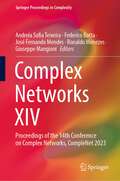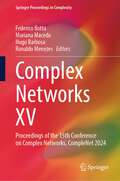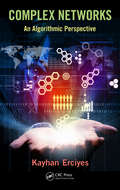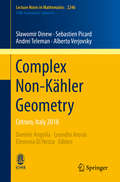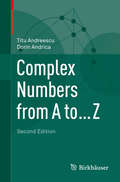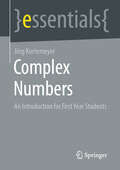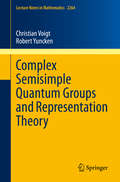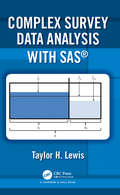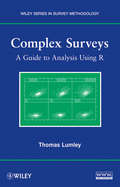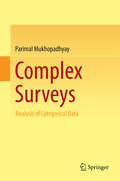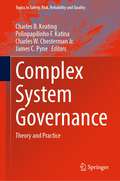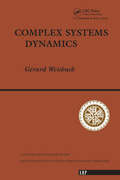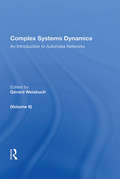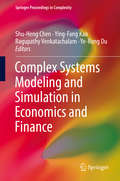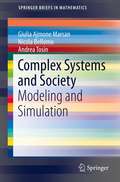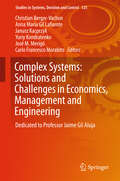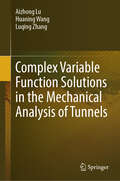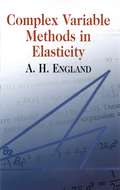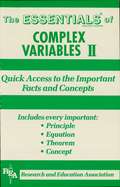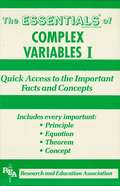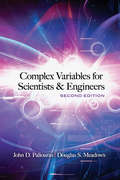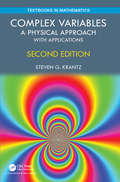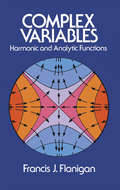- Table View
- List View
Complex Networks XIV: Proceedings of the 14th Conference on Complex Networks, CompleNet 2023 (Springer Proceedings in Complexity)
by Ronaldo Menezes Giuseppe Mangioni Andreia Sofia Teixeira José Fernando Mendes Federico BottaThis book contains contributions in the area of Network Science, presented at the 14th International Conference on Complex Networks (CompleNet), 24-28 April, 2023 in Aveiro, Portugal. CompleNet is an international conference on complex networks that brings together researchers and practitioners from diverse disciplines—from sociology, biology, physics, and computer science—who share a passion to better understand the interdependencies within and across systems. CompleNet is a venue to discuss ideas and findings about all types networks, from biological, to technological, to informational and social. It is this interdisciplinary nature of complex networks that CompleNet aims to explore and celebrate.The audience of the work are professionals and academics working in Network Science, a highly-multidisciplinary field.
Complex Networks XV: Proceedings of the 15th Conference on Complex Networks, CompleNet 2024 (Springer Proceedings in Complexity)
by Ronaldo Menezes Hugo Barbosa Federico Botta Mariana MacedoThe International Conference on Complex Networks (CompleNet) brings together researchers and practitioners from diverse disciplines working on areas related to complex networks. CompleNet has been an active conference since 2009. Over the past two decades, we have witnessed an exponential increase in the number of publications and research centres dedicated to this field of Complex Networks (aka Network Science). From biological systems to computer science, from technical to informational networks, and from economic to social systems, complex networks are becoming pervasive for dozens of applications. It is the interdisciplinary nature of complex networks that CompleNet aims to capture and celebrate. The CompleNet conference is one of the most cherished events by scientists in our field. Maybe it is because of its motivating format, consisting of plenary sessions (no parallel sessions); or perhaps the reason is that it finds the perfect balance between young and senior participation, a balance in the demographics of the presenters, or perhaps it is just the quality of the work presented.
Complex Networks: An Algorithmic Perspective
by Kayhan ErciyesComplex Networks: An Algorithmic Perspective supplies the basic theoretical algorithmic and graph theoretic knowledge needed by every researcher and student of complex networks. This book is about specifying, classifying, designing, and implementing mostly sequential and also parallel and distributed algorithms that can be used to analyze the static properties of complex networks. Providing a focused scope which consists of graph theory and algorithms for complex networks, the book identifies and describes a repertoire of algorithms that may be useful for any complex network.
Complex Non-Kähler Geometry: Cetraro, Italy 2018 (Lecture Notes in Mathematics #2246)
by Sławomir Dinew Sebastien Picard Andrei Teleman Alberto VerjovskyCollecting together the lecture notes of the CIME Summer School held in Cetraro in July 2018, the aim of the book is to introduce a vast range of techniques which are useful in the investigation of complex manifolds. The school consisted of four courses, focusing on both the construction of non-Kähler manifolds and the understanding of a possible classification of complex non-Kähler manifolds. In particular, the courses by Alberto Verjovsky and Andrei Teleman introduced tools in the theory of foliations and analytic techniques for the classification of compact complex surfaces and compact Kähler manifolds, respectively. The courses by Sebastien Picard and Sławomir Dinew focused on analytic techniques in Hermitian geometry, more precisely, on special Hermitian metrics and geometric flows, and on pluripotential theory in complex non-Kähler geometry.
Complex Numbers from A to ... Z
by Titu Andreescu Dorin Andrica* Learn how complex numbers may be used to solve algebraic equations, as well as their geometric interpretation * Theoretical aspects are augmented with rich exercises and problems at various levels of difficulty * A special feature is a selection of outstanding Olympiad problems solved by employing the methods presented * May serve as an engaging supplemental text for an introductory undergrad course on complex numbers or number theory
Complex Numbers: An Introduction for First Year Students (essentials)
by Jörg KortemeyerComplex numbers are a typical topic of basic mathematics courses. This essential provides a detailed introduction and presentation of essential aspects of dealing with complex numbers, on the one hand related to commonly occurring tasks and on the other hand embedded in basic mathematical content. This Springer essential is a translation of the original German 1st edition essentials Komplexe Zahlen by Jörg Kortemeyer, published by Springer Fachmedien Wiesbaden GmbH, part of Springer Nature in 2020. The translation was done with the help of artificial intelligence (machine translation by the service DeepL.com). A subsequent human revision was done primarily in terms of content, so that the book will read stylistically differently from a conventional translation. Springer Nature works continuously to further the development of tools for the production of books and on the related technologies to support the authors.
Complex Semisimple Quantum Groups and Representation Theory (Lecture Notes in Mathematics #2264)
by Christian Voigt Robert YunckenThis book provides a thorough introduction to the theory of complex semisimple quantum groups, that is, Drinfeld doubles of q-deformations of compact semisimple Lie groups. The presentation is comprehensive, beginning with background information on Hopf algebras, and ending with the classification of admissible representations of the q-deformation of a complex semisimple Lie group. The main components are: - a thorough introduction to quantized universal enveloping algebras over general base fields and generic deformation parameters, including finite dimensional representation theory, the Poincaré-Birkhoff-Witt Theorem, the locally finite part, and the Harish-Chandra homomorphism, - the analytic theory of quantized complex semisimple Lie groups in terms of quantized algebras of functions and their duals, - algebraic representation theory in terms of category O, and - analytic representation theory of quantized complex semisimple groups. Given its scope, the book will be a valuable resource for both graduate students and researchers in the area of quantum groups.
Complex Survey Data Analysis with SAS
by Taylor H. LewisComplex Survey Data Analysis with SAS® is an invaluable resource for applied researchers analyzing data generated from a sample design involving any combination of stratification, clustering, unequal weights, or finite population correction factors. After clearly explaining how the presence of these features can invalidate the assumptions underlying most traditional statistical techniques, this book equips readers with the knowledge to confidently account for them during the estimation and inference process by employing the SURVEY family of SAS/STAT® procedures. The book offers comprehensive coverage of the most essential topics, including: Drawing random samples Descriptive statistics for continuous and categorical variables Fitting and interpreting linear and logistic regression models Survival analysis Domain estimation Replication variance estimation methods Weight adjustment and imputation methods for handling missing data The easy-to-follow examples are drawn from real-world survey data sets spanning multiple disciplines, all of which can be downloaded for free along with syntax files from the author’s website: http://mason.gmu.edu/~tlewis18/. While other books may touch on some of the same issues and nuances of complex survey data analysis, none features SAS exclusively and as exhaustively. Another unique aspect of this book is its abundance of handy workarounds for certain techniques not yet supported as of SAS Version 9.4, such as the ratio estimator for a total and the bootstrap for variance estimation. Taylor H. Lewis is a PhD graduate of the Joint Program in Survey Methodology at the University of Maryland, College Park, and an adjunct professor in the George Mason University Department of Statistics. An avid SAS user for 15 years, he is a SAS Certified Advanced programmer and a nationally recognized SAS educator who has produced dozens of papers and workshops illustrating how to efficiently and effectively conduct statistical analyses using SAS.
Complex Surveys
by Thomas LumleyA complete guide to carrying out complex survey analysis using RAs survey analysis continues to serve as a core component of sociological research, researchers are increasingly relying upon data gathered from complex surveys to carry out traditional analyses. Complex Surveys is a practical guide to the analysis of this kind of data using R, the freely available and downloadable statistical programming language. As creator of the specific survey package for R, the author provides the ultimate presentation of how to successfully use the software for analyzing data from complex surveys while also utilizing the most current data from health and social sciences studies to demonstrate the application of survey research methods in these fields.The book begins with coverage of basic tools and topics within survey analysis such as simple and stratified sampling, cluster sampling, linear regression, and categorical data regression. Subsequent chapters delve into more technical aspects of complex survey analysis, including post-stratification, two-phase sampling, missing data, and causal inference. Throughout the book, an emphasis is placed on graphics, regression modeling, and two-phase designs. In addition, the author supplies a unique discussion of epidemiological two-phase designs as well as probability-weighting for causal inference. All of the book's examples and figures are generated using R, and a related Web site provides the R code that allows readers to reproduce the presented content. Each chapter concludes with exercises that vary in level of complexity, and detailed appendices outline additional mathematical and computational descriptions to assist readers with comparing results from various software systems.Complex Surveys is an excellent book for courses on sampling and complex surveys at the upper-undergraduate and graduate levels. It is also a practical reference guide for applied statisticians and practitioners in the social and health sciences who use statistics in their everyday work.
Complex Surveys: Analysis of Categorical Data
by Parimal MukhopadhyayThe primary objective of this book is to study some of the research topics in the area of analysis of complex surveys which have not been covered in any book yet. It discusses the analysis of categorical data using three models: a full model, a log-linear model and a logistic regression model. It is a valuable resource for survey statisticians and practitioners in the field of sociology, biology, economics, psychology and other areas who have to use these procedures in their day-to-day work. It is also useful for courses on sampling and complex surveys at the upper-undergraduate and graduate levels. The importance of sample surveys today cannot be overstated. From voters' behaviour to fields such as industry, agriculture, economics, sociology, psychology, investigators generally resort to survey sampling to obtain an assessment of the behaviour of the population they are interested in. Many large-scale sample surveys collect data using complex survey designs like multistage stratified cluster designs. The observations using these complex designs are not independently and identically distributed - an assumption on which the classical procedures of inference are based. This means that if classical tests are used for the analysis of such data, the inferences obtained will be inconsistent and often invalid. For this reason, many modified test procedures have been developed for this purpose over the last few decades.
Complex System Governance: Theory and Practice (Topics in Safety, Risk, Reliability and Quality #40)
by Polinpapilinho F. Katina Charles B. Keating Charles W. Chesterman Jr. James C. PyneThis book explores Complex System Governance (CSG)—an emerging field concerned with the design, execution, and evolution of essential functions necessary to ensure continued viability of a system. The book focuses on three primary development areas to better understand and utilize current developments CSG. First, the conceptual foundations for CSG are developed, from systems theory, management cybernetics, and governance. Second, a set of critical CSG topics are examined from conceptual as well as practice perspectives. Third, several development and application issues are discussed. Ultimately, CSG is positioned as an emerging field with strong theoretical grounding and significant implications for improving practices and performance to better address complex systems and their problems.
Complex Systems Dynamics
by Gerard WeisbuchFirst Published in 2018. Routledge is an imprint of Taylor & Francis, an Informa company.
Complex Systems Dynamics (volume Ii)
by Gerard WeisbuchThis book provides an accessible introduction to complex systems viewed as networks of automata, using primarily examples drawn from the physics of disordered systems, neural networks, and the origins of life. It is helpful for readers with a university education in science or engineering.
Complex Systems Modeling and Simulation in Economics and Finance (Springer Proceedings in Complexity)
by Shu-Heng Chen Ying-Fang Kao Ragupathy Venkatachalam Ye-Rong DuThis title brings together frontier research on complex economic systems, heterogeneous interacting agents, bounded rationality, and nonlinear dynamics in economics. The book contains the proceedings of the CEF2015 (21st Computing in Economics in Finance), held 20-22 June 2015 in Taipei, Taiwan, and addresses some of the important driving forces for various emergent properties in economies, when viewed as complex systems. The breakthroughs reported in this book are a result of an interdisciplinary approach and simulation remains the unifying theme for these papers as they deal with a wide range of topics in economics. The text is a valuable addition to the efforts in promoting the complex systems view in economic science. The computational experiments reported in the book are both transparent and replicable.Complex System Modeling and Simulation in Economics and Finance is useful for graduate courses of complex systems, with particular focus on economics and finance. At the same time it serves as a good overview for researchers who are interested in the topic.
Complex Systems and Society: Modeling and Simulation (SpringerBriefs in Mathematics)
by Giulia Ajmone Marsan Nicola Bellomo Andrea TosinThis work aims to foster the interdisciplinary dialogue between mathematicians and socio-economic scientists. Interaction among scholars and practitioners traditionally coming from different research areas is necessary more than ever in order to better understand many real-world problems we face today. On the one hand, mathematicians need economists and social scientists to better address the methodologies they design in a more realistic way; on the other hand, economists and social scientists need to be aware of sound mathematical modelling tools in order to understand and, ultimately, solve the complex problems they encounter in their research. With this goal in mind, this work is designed to take into account a multidisciplinary approach that will encourage the transfer of knowledge, ideas, and methodology from one discipline to the other. In particular, the work has three main themes: Demystifying and unravelling complex systems; Introducing models of individual behaviours in the social and economic sciences; Modelling socio-economic sciences as complex living systems. Specific tools examined in the work include a recently developed modelling approach using stochastic game theory within the framework of statistical mechanics and progressing up to modeling Darwinian evolution. Special attention is also devoted to social network theory as a fundamental instrument for the understanding of socio-economic systems.
Complex Systems in Finance and Econometrics
by Robert A. MeyersComplex Systems in Finance and Econometrics is an authoritative reference to the basic tools and concepts of complexity and systems theory as applied to an understanding of complex, financial-based business and social systems. Fractals, nonlinear time series modeling, cellular automata, game theory, network theory and statistical physics are among the essential tools and techniques for predicting, monitoring, evaluating, managing, and decision-making in a wide range of fields from health care, poverty alleviation, and energy and the environment, to manufacturing and quality assurance, model building, organizational learning. and macro and microeconomics. Sixty of the world's leading experts present 47 articles for an audience of advanced undergraduate and graduate students, professors, and professionals in all of these fields.
Complex Systems: Solutions and Challenges in Economics, Management and Engineering
by Janusz Kacprzyk Yuriy Kondratenko Christian Berger-Vachon Anna María Gil Lafuente José M. Merigó Carlo Francesco MorabitoThis book presents an authoritative collection of contributions reporting on fuzzy logic and decision theory, together with applications and case studies in economics and management science. Dedicated to Professor Jaume Gil Aluja in recognition of his pioneering work, the book reports on theories, methods and new challenges, thus offering not only a timely reference guide but also a source of new ideas and inspirations for graduate students and researchers alike.
Complex Variable Function Solutions in the Mechanical Analysis of Tunnels
by Aizhong Lu Huaning Wang Luqing ZhangThis book covers the mechanical problems of tunnels in traffic, hydraulic and mining engineering. By extending the complex variable method in mechanical analysis, it proposes accurate analytical solutions for tunnels. The solutions are further applied to the back analysis of tunnels, hole shape optimization, support design and estimation of tunnel stability. The considered rock characteristics involve elasticity, elastoplasticity, viscoelasticity and anisotropy, and various geometric conditions are included, such as circular/noncircular single/multiple tunnels with/without support at deep/shallow depths. Some original achievements are provided, including new mapping functions for complex regions, precise determination of the noncircular plastic zone around single/twin tunnels and related elastoplastic solutions and quantitative analysis of the interaction between rock and the support, which are new developments of theory and method in rock mechanics. The proposed analyticalsolutions are reliable tools to initially estimate the design parameters and achieve optimal design, providing guidance in the conceptual stage of the design process. They can clearly reveal the influences of parameters in functional form and provide a benchmark against which the overall correctness of numerical analyses can be assessed. This book summarizes the author's research achievements over more than 20 years. It is a valuable reference for professionals working in geotechnical engineering.
Complex Variable Methods in Elasticity
by A. H. EnglandThe plane strain and generalized plane stress boundary value problems of linear elasticity are the focus of this graduate-level text, which formulates and solves these problems by employing complex variable theory. The text presents detailed descriptions of the three basic methods that rely on series representation, Cauchy integral representation, and the solution via continuation. Its five-part treatment covers functions of a complex variable, the basic equations of two-dimensional elasticity, plane and half-plane problems, regions with circular boundaries, and regions with curvilinear boundaries. Worked examples and sets of problems appear throughout the text. 1971 edition. 26 figures.
Complex Variables II Essentials
by Alan D. SolomonREA’s Essentials provide quick and easy access to critical information in a variety of different fields, ranging from the most basic to the most advanced. As its name implies, these concise, comprehensive study guides summarize the essentials of the field covered. Essentials are helpful when preparing for exams, doing homework and will remain a lasting reference source for students, teachers, and professionals. Complex Variables II includes elementary mappings and Mobius transformation, mappings by general functions, conformal mappings and harmonic functions, applying complex functions to applied mathematics, analytic continuation, and analytic function properties.
Complex Variables II Essentials
by Alan D. SolomonREA's Essentials provide quick and easy access to critical information in a variety of different fields, ranging from the most basic to the most advanced. As its name implies, these concise, comprehensive study guides summarize the essentials of the field covered. Essentials are helpful when preparing for exams, doing homework and will remain a lasting reference source for students, teachers, and professionals. Complex Variables II includes elementary mappings and Mobius transformation, mappings by general functions, conformal mappings and harmonic functions, applying complex functions to applied mathematics, analytic continuation, and analytic function properties.
Complex Variables Introduction and Applications
by Mark J. Ablowitz Athanassios S. FokasIn addition to being mathematically elegant, complex variables provide a powerful tool for solving problems that are either very difficult or virtually impossible to solve in any other way. Part I of this text provides an introduction to the subject, including analytic functions, integration, series, and residue calculus and also includes transform methods, ODEs in the complex plane, numerical methods and more. Part II contains conformal mappings, asymptotic expansions, and the study of Riemann-Hilbert problems. The authors also provide an extensive array of applications, illustrative examples and homework exercises. This book is ideal for use in introductory undergraduate and graduate level courses in complex variables.
Complex Variables for Scientists and Engineers: Second Edition (Dover Books on Mathematics)
by John D. Paliouras Douglas S. MeadowsThis outstanding text for undergraduate students of science and engineering requires only a standard course in elementary calculus. Designed to provide a thorough understanding of fundamental concepts and create the basis for higher-level courses, the treatment features numerous examples and extensive exercise sections of varying difficulty, plus answers to selected exercises.The two-part approach begins with the development of the primary concept of analytic function, advancing to the Cauchy integral theory, the series development of analytic functions through evaluation of integrals by residues, and some elementary applications of harmonic functions. The second part introduces some of the deeper aspects of complex function theory: mapping properties of analytic functions, applications to various vector field problems with boundary conditions, and a collection of further theoretical results. 1990 edition.
Complex Variables: A Physical Approach with Applications (Textbooks in Mathematics #Vol. 40)
by Steven G. KrantzThe idea of complex numbers dates back at least 300 years—to Gauss and Euler, among others. Today complex analysis is a central part of modern analytical thinking. It is used in engineering, physics, mathematics, astrophysics, and many other fields. It provides powerful tools for doing mathematical analysis, and often yields pleasing and unanticipated answers. This book makes the subject of complex analysis accessible to a broad audience. The complex numbers are a somewhat mysterious number system that seems to come out of the blue. It is important for students to see that this is really a very concrete set of objects that has very concrete and meaningful applications. <P><P>Features: <li>This new edition is a substantial rewrite, focusing on the accessibility, applied, and visual aspect of complex analysis <li>This book has an exceptionally large number of examples and a large number of figures. <li>The topic is presented as a natural outgrowth of the calculus. It is not a new language, or a new way of thinking. <li>Incisive applications appear throughout the book. <li>Partial differential equations are used as a unifying theme.
Complex Variables: Harmonic And Analytic Functions (Dover Books on Mathematics)
by Francis J. FlaniganA caution to mathematics professors: Complex Variables does not follow conventional outlines of course material. One reviewer noting its originality wrote: "A standard text is often preferred [to a superior text like this] because the professor knows the order of topics and the problems, and doesn't really have to pay attention to the text. He can go to class without preparation." Not so here -- Dr. Flanigan treats this most important field of contemporary mathematics in a most unusual way. While all the material for an advanced undergraduate or first-year graduate course is covered, discussion of complex algebra is delayed for 100 pages, until harmonic functions have been analyzed from a real variable viewpoint. Students who have forgotten or never dealt with this material will find it useful for the subsequent functions. In addition, analytic functions are defined in a way which simplifies the subsequent theory. Contents include: Calculus in the Plane, Harmonic Functions in the Plane, Complex Numbers and Complex Functions, Integrals of Analytic Functions, Analytic Functions and Power Series, Singular Points and Laurent Series, The Residue Theorem and the Argument Principle, and Analytic Functions as Conformal Mappings. Those familiar with mathematics texts will note the fine illustrations throughout and large number of problems offered at the chapter ends. An answer section is provided. Students weary of plodding mathematical prose will find Professor Flanigan's style as refreshing and stimulating as his approach.
